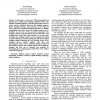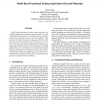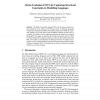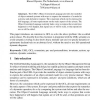EDOC
2011
IEEE
13 years 4 months ago
2011
IEEE
—In this paper, we present a UML metamodel-based approach for creating and executing workflow models. The modeling language is introduced through its abstract syntax, and an eval...
ICSE
2009
IEEE-ACM
14 years 2 months ago
2009
IEEE-ACM
Model driven functional system testing generates test scenarios from behavioural and structural models. In order to autmatically generate tests, conditions such as invariants and ...
IAJIT
2008
14 years 5 months ago
2008
: UML currently still lacks a rigorously defined semantics for its models, which makes formally analyzing a model and verifying its properties extremely difficult. To remedy that, ...
ECEASST
2008
14 years 5 months ago
2008
Executable UML allows precisely describing the software system at level of abstraction. The executable models can be translated to a less programming language completely or execute...
ECEASST
2008
14 years 5 months ago
2008
The OCL (Object Constraint Language) as part of the UML (Unified Modeling Language) is a rich language with different collection kinds (sets, multi-sets, sequences) and a large var...
BIRTHDAY
2009
Springer
14 years 6 months ago
2009
Springer
Abstract. The Object Constraint Language (OCL) can be used to capture strucnstraints in the context of the abstract syntax of modelling languages (metamodels) defined in the MOF me...
UML
2000
Springer
14 years 8 months ago
2000
Springer
The purpose of this paper is to first showcase the concept of an operation schema--a precise form of system-level operation specification--and secondly show how operation schemas e...
UML
2000
Springer
14 years 8 months ago
2000
Springer
The UML's Object Constraint Language provides the modeller of object-oriented systems with ways to express the semantics of a model in a precise and declarative manner. The co...
UML
1998
Springer
14 years 9 months ago
1998
Springer
The object Constraint Language (OCL), which forms part of the UML set of modelling notations, is a precise, textual language for expressing constraints that cannot be shown diagram...
UML
1999
Springer
14 years 9 months ago
1999
Springer
The Object Constraint Language (OCL) is a precise language for notating behavioural constraints on UML models. Constraint diagrams have been proposed as a means of notating similar...




